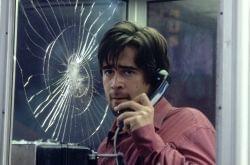Phone Booth

Director(s): Joel Schumacher
Writer(s): Larry Cohen
Cast: Colin Farrell, Kiefer Sutherland, Forest Whitaker, Radha Mitchell and Katie Holmes
Reviewed by: Ian Evans on
Release Date(s)
Apr 4, 2003 - WideIn Joel Schumacher’s Phone Booth, publicist Stu Shepard (Colin Farrell) seems to have it all: fancy suits, expensive watches, an eager young assistant and a loving wife. We soon discover that Stu Shepard’s life is a sham. He plays nonexistent magazine cover offers for his C-level clients against each other, he treats his assistant as if he’s easily disposable and he’s trying to lure a beautiful young client (Katie Holmes) into bed.
To stop his wife from noticing the daily calls to the young actress, Stu (who juggles cell phone calls like a circus act), makes a daily stop at the last phone booth in Manhattan. This day the phone rings and Stu answers it. The caller knows a lot about his life: the daily calls to the actress, where he lives, where his wife works. Shepard tires of the head games and says he’s hanging up. The Caller (Kiefer Sutherland) warns him that he’s got a sniper’s rifle trained on him and will kill him if he hangs up. To prove his point he kills one of the street’s seedier denizens. Soon a squad of police, led by Captain Ramey (Forest Whitaker), surrounds the booth, convinced that Stu is the killer. Unable to hang up, Stu faces being shot by either the police or the sniper if he makes the wrong move. The situation he’s in forces him to face his mortality as well as his morality.
Director Joel Schumacher shot Phone Booth in a tight 10-day schedule. Except for a few brief excursions to other locations, the grand majority of this eighty-minute film takes place in the space surrounding the phone booth. Colin Farrell doesn’t have a lot of physical space to ply his craft in. The phone booth becomes his character’s confessional. He doesn’t have explosions and helicopter shots to take the attention away from him and Farrell steps up to the challenge of expressing his fear, anger and frustration while acting opposite a disembodied voice. The exchanges between Farrell and Sutherland seem to have a natural rhythm, a feat that is made more amazing by the fact that Farrell was running his lines with a production assistant, and Sutherland’s voice was put in during post-production. Forest Whitaker also gives a strong performance as a cop who must battle what he sees — a dead body, eyewitnesses, and a seemingly deranged man in a phone booth — against what he senses, that he’s actually facing a twisted hostage situation. He remains calm in a situation where the slightest wrong move could end up with his officers shooting Shepard. Sutherland’s twisted sniper toys with Farrell perfectly. As mentioned earlier, his performance is even more extraordinary given the fact that he didn’t get to interact directly with the other performers.
Farrell’s performance, and Schumacher’s quick paced shooting, give the audience just the right amount of time to suspend their disbelief and enjoy the experience. If the film had been any longer, we might have found ourselves looking for plot holes but as it stands we easily go along for the ride. How Schumacher fit an emotional roller coaster into a phone booth is a testament to his casting ability and his direction.
This film’s release was held back twice. Once to await the release of Minority Report, which would make Farrell a more bankable name, and next when its release date fell too close to the real-life Beltway sniper attacks. Audiences finally get the chance to see a great performance by a rising star.